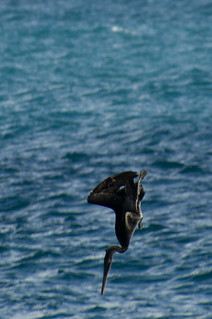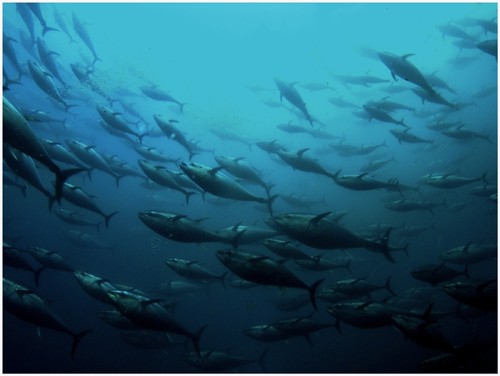February 12, 2013
Japanese Fishery Meets Challenge to Reduce Bycatch from World's Oceans (Part Two)
Keywords: Ecosystems / Biodiversity Food Newsletter
JFS Newsletter No.125 (January 2013)
The World Wide Fund for Nature (WWF), one of the world's largest conservation organizations, was set up to protect endangered wildlife. One of its activities is to host the International Smart Gear Competition to promote fishing gear that helps protect marine life. In 2011, a Japanese fishery group won this competition's grand prize.
Through the courtesy of WWF Japan, we will present the latter half of the interview about this group's inventive approaches and fishing gear development in our newsletter.
Japanese Fishery Meets Challenge to Reduce Bycatch from World's Oceans (Part One)
------------------------
Internationally Recognized Double-Weight Branchline: Expectations for its Wider Use
Q: Is there any movement to promote the wider use of double-weight branchlines?
A: We are now in the process of determining detailed specifications and hope to use them not only in the 200 nautical mile exclusive economic zone (EEZ) of South Africa, but in Brazil's EEZ as well.
We were also invited to give a presentation on double-weight branchlines at a meeting of the Seabird Bycatch Working Group of the Agreement on the Conservation of Albatrosses and Petrels (ACAP), which was held in the summer of 2011 in Ecuador.
The prize money we received from the International Smart Gear Competition had "strings" attached, a requirement that we use it for activities to promote the use of double-weight branchlines (laughter).
We have also provided explanatory CDs about double-weight branchlines to leading companies owning tuna-fishing vessels in Taiwan, Korea and China, and will hold workshops jointly with ACAP and Birdlife International, with the help of Japan's Fisheries Agency.
We fully understand that our approach will not be effective unless vessels out of China, Taiwan, Korea and Europe also use double-weight branchlines.
Q: I've heard that binding provisions have been adopted under international fisheries agreements.
A: It was decided at the International Commission for the Conservation of Atlantic Tunas (ICCAT) in 2011 that longline vessels should use at least two of the three existing seabird bycatch mitigation measures in the Atlantic Ocean south of 30 degrees south latitude starting in July 2013: (1) weighted branchlines, (2) tori lines (gear designed to scare seabirds away) and (3) nighttime casting.
The Indian Ocean Tuna Commission (IOTC) also decided that the same rule will apply in the Indian Ocean south of 25 degrees south latitude starting in 2014. Both provisions are binding.
The reason for the time lag of about a year between adoption and implementation of these measures is that it takes some time for vessels that are away from Japan for more than a year to learn the methods and procure the gear. Although we had some criticism that this is too slow, we believe that this amount of time will be necessary
Q: Why was it decided to require only two out of the three measures?
A: One of the most common situations when seabirds dive into the sea to grab bait fish is when the longlines are first put into the sea. To avoid catching seabirds at this juncture, we use the tori line in an area about 100 meters out from the stern of our vessels. Then, the double-weight branchlines rapidly sink the baited hooks just beyond that.
However, the agreements adopted by ICCAT and IOTC only specify "weighted branchlines" as an option -- not necessarily "double-weight branchlines."
However, using weighted branchlines with only one lead weight each is dangerous to fishermen and lowers fishing efficiency. For that reason, we have had ICCAT allow fishermen to flexibly decide the specifications of the branchlines they adopt, with the aim of enabling them to adopt double-weight branchlines.
Aiming for Fisheries Friendly to both Humans and Seabirds

Image by hankplank.
Some Rights Reserved.
Q: Is nighttime casting effective?
A: Many seabirds rely on their vision when they dive into the sea to grab bait fish so, casting long lines at night is effective to prevent bycatch.
However, in order to cast a line in the dark, fishermen have to use a light to illuminate their hands. They use only a small light, but its light is scattered around with the movements of the ship. This enables seabirds to find the bait fish and fly towards the line.
Nighttime casting also means reduced sleep for fishermen. Normally, they begin casting lines at around 4 in the morning, but in order to finish the operation before sunrise, they need to begin at 1 or 2 in the morning. This forces them to cut their sleep hours, resulting in safety and health problems.
From this perspective, as a fisherman, I cannot accept nighttime casting. Taking into consideration all aspects, including the safety and health of fishermen, fishing efficiency, and effective prevention of bycatch, the best method is double-weight branchlines.
Q: What do you think "preventing bycatch" means to fishermen?
A: From the perspective of longline fishing, preventing bycatch means preventing seabirds from stealing bait fish and being caught on hooks. However, and more importantly, bycatch mitigation is for us an issue that can no longer be avoided.
Because, I think that if we try avoid this issue, it will mean the end of tuna longline fishing.
In this context, we have finally come up with a method based on the experience of one of our on-site chief fishermen that we are convinced will work.
That is why we are eager to lose no time in introducing this method to other organizations and countries overseas. I hope that fishing operations will no longer be restricted due to bycatch problems and that we can continue to fish without anxiety.
I also keenly hope that environmental organizations, which have been criticizing fisheries due to bycatch problems, will instead inform the public of our initiative to prevent bycatch -- an initiative that is now poised for practical application.
------------------------
From WWF Japan's article Japanese Fishery's Challenge to Reduce Bycatch from World's Oceans (in Japanese)
http://www.wwf.or.jp/activities/2012/06/1071528.html
Related
"JFS Newsletter"
- 'Good Companies in Japan' (Article No.4): 'Eightfold Satisfaction' Management for Everyone's Happiness
- "Nai-Mono-Wa-Nai": Ama Town's Concept of Sufficiency and Message to the World
- 'Yumekaze' Wind Turbine Project Connects Metro Consumers and Regional Producers: Seikatsu Club Consumers' Co-operative
- Shaping Japan's Energy toward 2050 Participating in the Round Table for Studying Energy Situations
- 'Good Companies in Japan' (Article No.3): Seeking Ways to Develop Societal Contribution along with Core Businesses



